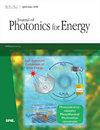Numerical investigation on solar evaporation properties of nanofluids
IF 2.1
4区 工程技术
Q4 MATERIALS SCIENCE, MULTIDISCIPLINARY
引用次数: 0
Abstract
Abstract. The optical absorption and heat transfer properties of fluid can be improved by suspending nanoparticles in a base fluid. Due to the strong photothermal effect around nanoparticles, water around the particles evaporates when exposed to light. Therefore, nanofluids can be used as the working fluid of solar evaporation devices. The evaporation heat transfer model of the Ag nanofluid is established. The temperature distribution and vapor concentration distribution around nanofluids are simulated at low concentrated solar power. Effects of the particle size and volume concentration on the evaporation performance are analyzed. When the volume concentration is small (fv = 0.01 % ), the effect of particle size on evaporation is obvious, and the evaporation increases with the increase of particle size. When the particle radius R increases from 5 to 40 nm, the evaporation amount increases 17.8% from 0.0286 to 0.0337 g. For the nanofluids with smaller particle sizes (R < 20 nm), the evaporation tends to be stable with the increase of concentration, reaching about 0.0318 g. For the nanofluids with larger particle sizes (R = 40 nm), the evaporation decreases significantly with the increased concentration. When the volume concentration increases from 0.01% to 0.1%, the evaporation decreases from 0.0337 to 0.0288 g. Therefore, the particle size and volume concentration should be considered comprehensively when choosing nanofluids as evaporation working fluids. When the volume concentration is >0.05 % , the nanofluids with smaller particle sizes should be selected. We provide guidance for the utilization of nanofluids for solar evaporation.纳米流体太阳蒸发特性的数值研究
摘要通过将纳米颗粒悬浮在基础流体中,可以改善流体的光学吸收和传热性能。由于纳米颗粒周围的强光热效应,当暴露在光下时,颗粒周围的水会蒸发。因此,纳米流体可以用作太阳能蒸发装置的工作流体。建立了银纳米流体的蒸发传热模型。模拟了低浓度太阳能下纳米流体周围的温度分布和蒸汽浓度分布。分析了颗粒大小和体积浓度对蒸发性能的影响。当体积浓度较小时(fv = 0.01 % ), 颗粒大小对蒸发量的影响明显,蒸发量随颗粒大小的增加而增加。当颗粒半径R从5纳米增加到40纳米时,蒸发量从0.0286克增加到0.0337克,增加了17.8%。对于具有较小颗粒尺寸的纳米流体(R 0.05 % , 应当选择具有较小颗粒尺寸的纳米流体。我们为利用纳米流体进行太阳能蒸发提供指导。
本文章由计算机程序翻译,如有差异,请以英文原文为准。
求助全文
约1分钟内获得全文
求助全文
来源期刊

Journal of Photonics for Energy
MATERIALS SCIENCE, MULTIDISCIPLINARY-OPTICS
CiteScore
3.20
自引率
5.90%
发文量
28
审稿时长
>12 weeks
期刊介绍:
The Journal of Photonics for Energy publishes peer-reviewed papers covering fundamental and applied research areas focused on the applications of photonics for renewable energy harvesting, conversion, storage, distribution, monitoring, consumption, and efficient usage.
 求助内容:
求助内容: 应助结果提醒方式:
应助结果提醒方式:


